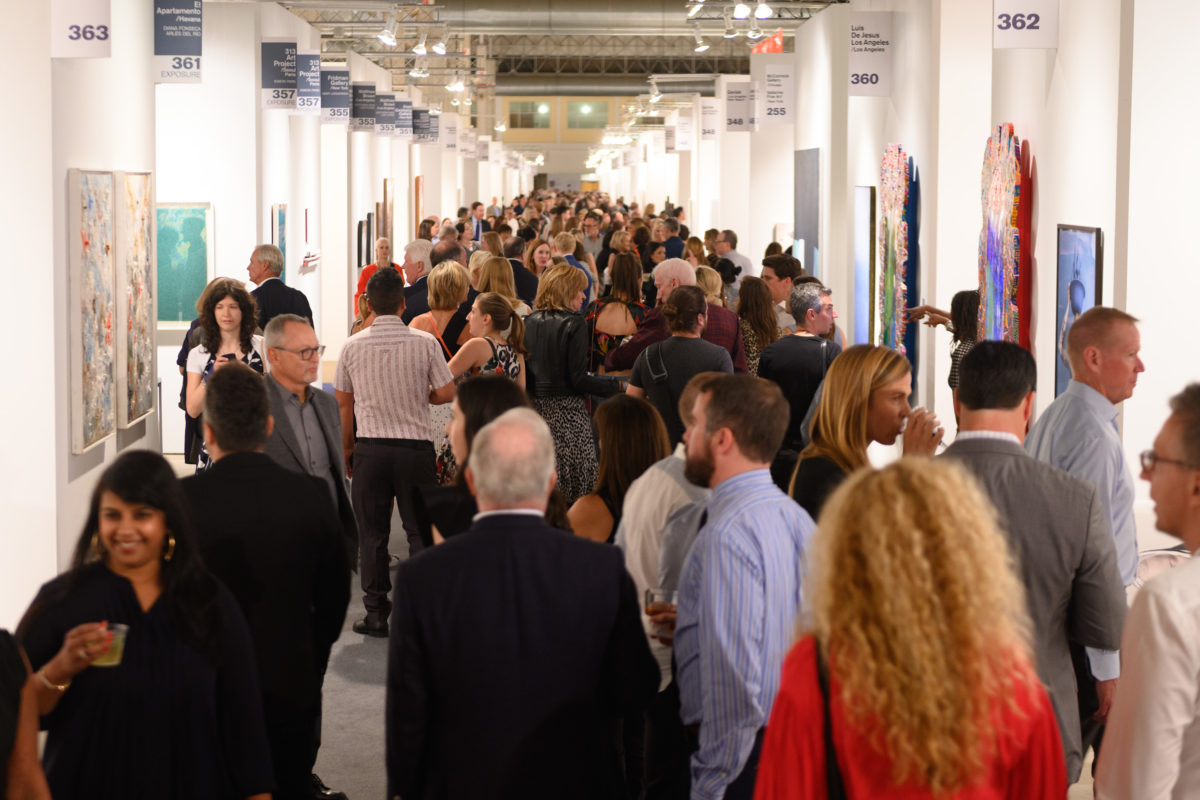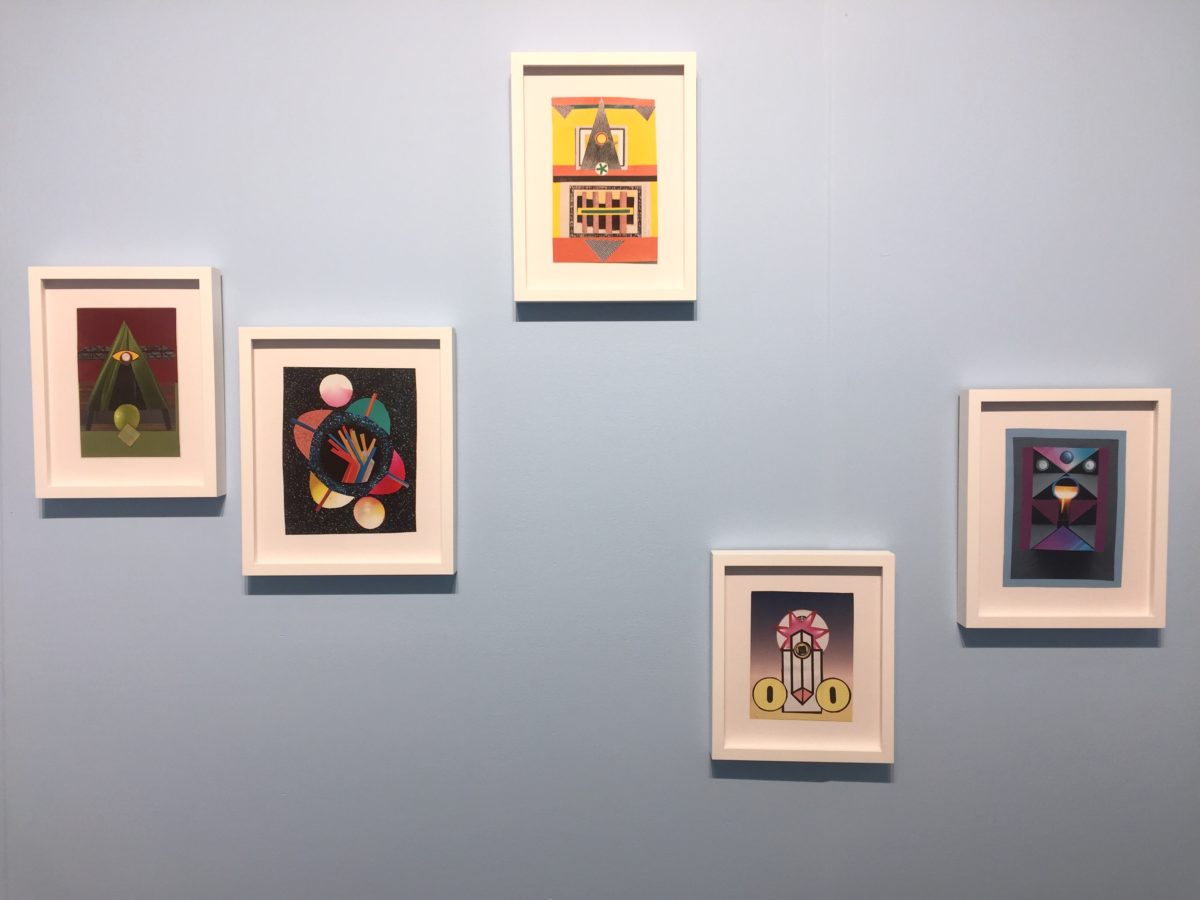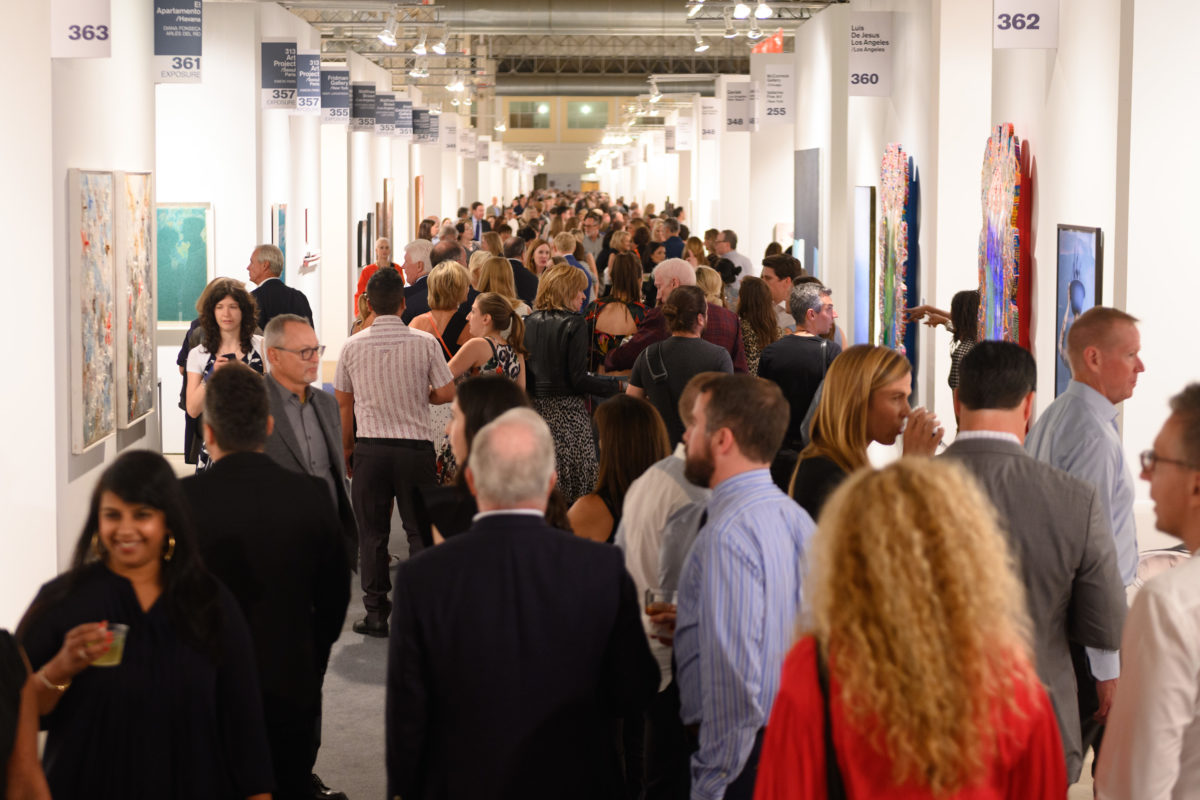[ad_1]

Expo Chicago’s opening.
DANIEL BOCZARKSI
Blue skies hovered over Chicago as two art fairs got underway this week, the more established Expo Chicago on Thursday and, starting Wednesday morning, the inaugural Chicago Invitational presented by the New Art Dealers Alliance (NADA). For the eighth annual Expo, 135 galleries set up shop in a vast exhibition hall at the tip of the lakefront destination Navy Pier, with dealers from all over eager to tap the Windy City’s caste of sophisticated collectors and strong institutional presence.
“The institutions here are incredible and very, very welcoming, which is not necessarily a usual thing,” said Nick Koenigsknecht, a partner of Peres Projects in Berlin. “In New York, the museum doesn’t come and thank you for coming to the fair, whereas here, they send their curatorial teams to really see what people are bringing. That’s unique and kind of amazing.”
Peres Projects is showing work by two artists spanning the globe: the Argentinian Ad Minoliti and Ajarb Bernard Ategwa from Cameroon, with paintings by both in bright orange, turquoise, and pink looking striking against the booth’s yellow, blue, and white walls. On opening night, Koenigsknecht said he expected action in the days to come, as Expo runs through Sunday. “It’s not like this mad rush on the first day, but there’s a continued interest and engagement level throughout the entire week.”
Harper’s Books, in town from New York City and East Hampton, on Long Island, mounted a solo exhibition of work by the up-and-coming painter Marcus Brutus—the subject of a recently published monograph (The Uhmericans, published by Harper’s this summer) and shows at the gallery’s two locations. (One of those shows was titled “Go To Work. Get Your Money and Come Home. You Don’t Live There.”)
“We’ve had a lot of success with his work,” Harper Levine said of Brutus, a self-taught painter of black Americans in all sorts of settings and scenarios. Several paintings had sold by the middle of opening day, including The Mechanic, for $8,000. “We’re happy to be at Expo Chicago because we’re trying to get more institutional support,” Levine said. “We have curators coming, and also people who are not from New York, who don’t know the work.”

Ebony G. Patterson, …made for kids…, 2018, at the booth of Monique Meloche Gallery, of Chicago.
COURTESY THE ARTIST AND MONIQUE MELOCHE GALLERY, CHICAGO
Representatives from Whitechapel Gallery and Timothy Taylor, both of London, said they detected a conservative strain to Chicago collectors’ taste. “It’s kind of the biggest names, things that are safe things to collect,” Connie Butler, an editions assistant for Whitechapel, said when asked what had sold early on.
Monique Meloche, a longtime Chicago dealer whose namesake gallery dates back to 2001, had a booth full of visitors in the afternoon. “Expo gives me this opportunity to showcase the breadth of our program, which is predominantly focused on artists of color,” she said. “It’s nice to show the diversity of the program. But it also shows how they all work together.”
Meloche’s booth features eight artists from her roster: Cheryl Pope, Ebony G. Patterson, Maia Cruz Palileo, David Antonio Cruz, Sanford Biggers, Nate Young, Brendan Fernandes, and Genevieve Gaignard. One of Patterson’s signature installations, …made for kids… (2018), consists of 150 toy guns stacked upright against the wall, hand-embellished with colorful fabric, gems, rhinestones, and other jewelry. Across the way, Gaignard’s Amazing Grace (2019) stood like an altar, with a white quilt adorned by an eagle and stars hanging below a mantle decorated with ceramic figurines, doilies, and found photographs.
Meloche said she liked the early mix at Expo this year. “I’m delighted—I’ve already sold all the big installations. This year in particular, there are so many more collectors from out of town who have come in.”

Jaume Plensa, Grace, 2018.
COURTESY THE ARTIST AND RICHARD GRAY GALLERY, CHICAGO
Richard Gray Gallery—based in Chicago since its founding in 1963 by Richard Gray, who died last year at the age of 89—has participated in Expo since the fair’s inception in 2012. “It’s not quite as broad an international attendance [as other art fairs], but it’s a solid, really good crowd,” said Paul Gray, Richard’s son. “I’m glad it’s here in my city.”
The gallery is showing a representative selection of work by artists from its roster, including a sculpture by Jaume Plensa and paintings by Alex Katz. “Our first priority is to try to represent the artists at the highest possible level,” Gray said. “We typically talk to artists in advance and make sure we have examples that haven’t been seen before.”
While Expo remains the city’s main draw, Gray said he thought the nearby Chicago Invitational had helped draw in a more diverse audience this year. “I wouldn’t say it’s a radical shift,” he said of the new addition to the calendar organized by NADA. “But it brings more people in town, some that might not have come otherwise.”
When the new event was first announced in April, 10 months after NADA announced the cancellation of its fair in New York, Heather Hubbs, the executive director of NADA, said, “Historically, Chicago has been a hotbed of artist-run galleries and alternative spaces. The city then and now embodies the experimental spirit of NADA, and we look forward to connecting our exhibitors with this audience.”
The idea is now a reality with 39 exhibitors from 19 cities set up throughout the Chicago Athletic Association Hotel in the heart of downtown, a block from the Art Institute of Chicago. The setting makes for a more eclectic atmosphere, such as the one surrounding a presentation by Detroit-based gallery Reyes | Finn: an open-plan room that formerly housed a swimming pool. The gallery’s ground-floor booth (it also has another on the fourth floor) is home to minimalist ceramic sculptures by Marie Hermann, who had also draped the walls with canvas and then lathered them with wet clay. “It was drying until yesterday,” said gallery director Terese Reyes, who noted that the Invitational had been receiving steady traffic since its opening on Wednesday.

The booth of Proyectos Ultravioleta, of Guatemala City, at the NADA Chicago Invitiational, with works by Elisabeth Wild.
COURTESY PROYECTOS ULTRAVIOLETA
Stefan Benchoam, co-founder of the Proyectos Ultravioleta gallery in Guatemala City, said he found the Invitational audience very engaged, with early sales registered for futuristic cut-paper collage works by 97-year-old Elisabeth Wild. “She’s able to kind of turn them into painting in a way,” Benchoam said of Wild’s creations.
Synchronicity with an institutional show has been an aid. “It’s helped that she’s showing at the Art Institute,” Benchoam said of 30 collages by Wild currently on view as part of an exhibition of six nominees for acquisitions by the Institute’s Society for Contemporary Art (the other notables being Maren Hassinger, Lubaina Himid, Toyin Ojih Odutola, Letícia Parente, and Heimo Zobernig). “I think they either consciously or subconsciously recognize that and make that connection. And she’s been getting a lot more attention the last few years—deservedly so.”
Natalie Popovic Schuh, the owner/director of Chicago-based gallery Regards, said she sees the coupling of Expo and the Chicago Invitational as mutually beneficial. “It’s good to have two fairs in the city, working off each other and bringing more people in,” she said. “Institutions are great here, and private collections, I have found, are really supportive of Chicago. And you have younger collectors building relationships with younger galleries—I think that’s important.”
Popovic Schuh also noted how helpful art fairs—however taxing they might be on dealers traveling and paying to participate in evermore of them filling up the calendar—can be for gallery ecosystems in the cities they take place in. “Fairs bring people to galleries—we definitely have an uptick during the fairs,” she said. “That’s something all galleries and institutions benefit from. As long as people show up and support, there’ll be more fairs.”
[ad_2]
Source link

